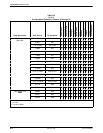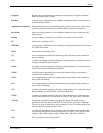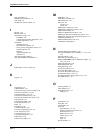
COMSPHERE 3821Plus Modem
Glossary-6 February 1998 3821-A2-GB20-30
Originate mode The state of a modem ready to transmit a call. In a dial network, it is the modem that
makes the call. In a leased-line network, it is one of two sides of the network that is
selected to be the originating modem.
parity A way of checking data accuracy by counting the number of bits that have a value of
one.
PBX Telephone switching equipment (Private Branch Exchange) dedicated to one customer.
A PBX connects private telephones to each other and to the public dial network.
permissive interface A dial modem operating mode characterized by a fixed output power level of –9 dBm. It
is one of two possible modes of operation for modems connected to dial lines (see
programmable interface).
power-up self-test A test that checks most hardware components when the modem is powered-on.
product code A three-digit code indicating the modem’s highest VF data rate.
programmable interface A dial modem operating mode characterized by an output power level (–12 to 0 dBm)
set by a programming resistor in the jack. It is one of two possible modes of operation
for modems connected to dial lines (see permissive interface).
protocol The rules for timing, format, error control, and flow control during data transmission.
PSTN Public Switched Telephone Network. A network shared among many users who can use
telephones to establish connections between two points. Also known as dial network.
pulse dialing One of two dialing methods, in which telephone numbers are sent as pulses (brief
changes in voltage or current intensity) across the telephone line. Rotary telephones use
pulse dialing.
register A part of the modem’s memory that contains values that determine the modem’s
operating characteristics.
remote loopback A test that sends a signal to the remote modem to test the local modem, the remote
modem, and the circuit between them.
result code An asynchronous message (in either numbers or words) that the modem sends to the
DTE after executing or trying to execute a command.
RJ11 A type of 6-position jack normally used with permissive dial networks and telephone
sets.
RJ45 A type of 8-position jack normally used with programmable dial networks.
rotary A TELCO service whereby multiple lines to a customer site share a common telephone
number.
SDCP Shared Diagnostic Control Panel. The feature that allows a number of carrier-mounted
devices to be controlled by a single control panel. Installed on one COMSPHERE 3000
Series Carrier, the SDCP permits control and configuration of devices in up to 8 carriers.
serial transmission A way of transmitting data in which bits are sent sequentially one at a time.


















